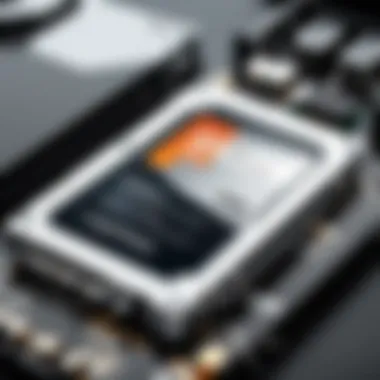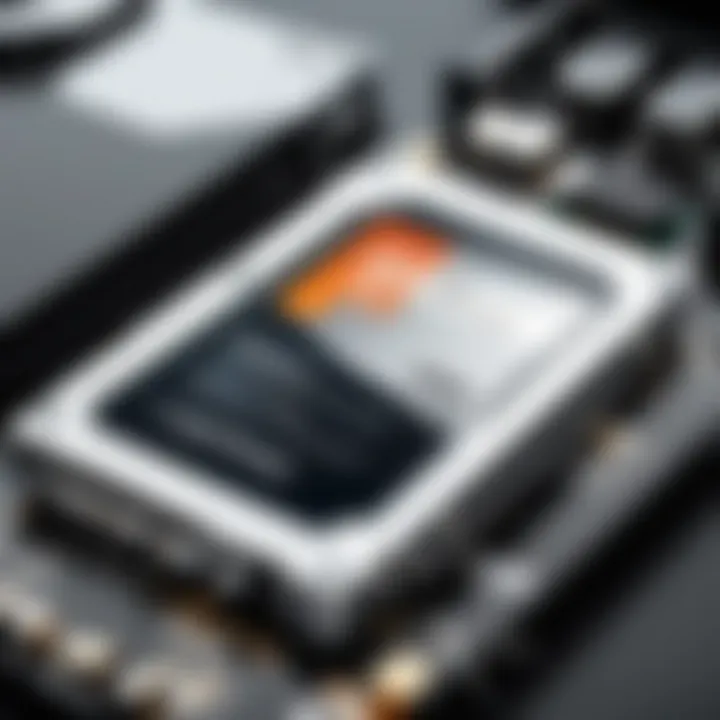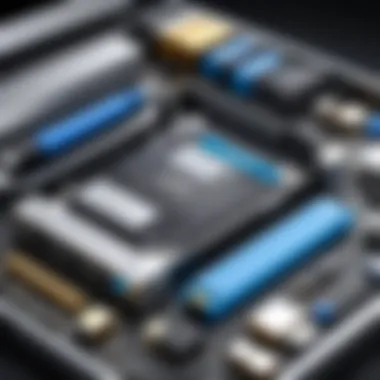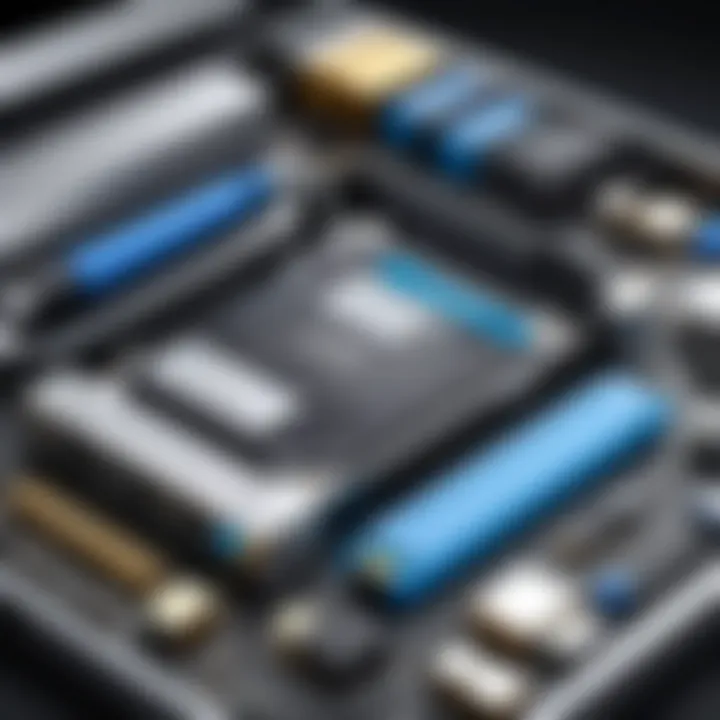Moving Windows OS from HDD to SSD: A Complete Guide


Intro
Transitioning from a traditional hard disk drive (HDD) to a solid-state drive (SSD) can significantly enhance computer performance. More users are realizing that upgrading their storage device provides advantages beyond just speed. This guide aims to inform tech enthusiasts and professionals on how to successfully migrate Windows OS from an HDD to an SSD. The process can seem daunting at first, but with proper knowledge and implementation, one can transform their computer experience.
Understanding the fundamental differences between HDDs and SSDs is crucial. HDDs use mechanical parts to read and write data, which can lead to slower performance and increased susceptibility to physical damage. On the other hand, SSDs utilize flash memory, resulting in faster data access, reduced boot times, and overall improved responsiveness.
This article will cover the necessary prerequisites for migration, offer a step-by-step guide, and suggest troubleshooting methods to address potential issues during the transfer.
Product Overview
Brand Information
There are several well-known brands that manufacture SSDs, including Samsung, Crucial, and Western Digital. Each of these brands offers a range of products designed to cater to different user needs, whether for everyday use or high-performance gaming.
Key Specifications
The specifications of SSDs vary based on factors like capacity, form factor, and read/write speeds. Most consumer SSDs range from 256GB to 2TB, with NVMe drives offering faster speeds compared to SATA SSDs. For instance, a Samsung 970 EVO can provide read speeds up to 3,500 MB/s, which is significantly faster than traditional HDDs.
Pricing
Pricing can differ markedly depending on capacity and technology. A typical SATA SSD might start around $50 for 500GB, while an NVMe SSD can be more expensive, sometimes reaching $200 or more for similar capacities. However, considering the performance benefits, the investment is often justified.
Performance Comparison
Benchmark Tests
Performance tests are a great way to evaluate SSD capabilities against HDDs. In various benchmarks, SSDs consistently outperform HDDs in tasks such as booting the operating system, loading applications, and transferring files.
Speed and Efficiency Comparisons
- Boot Time: SSDs typically boot Windows in under 20 seconds, while HDDs can take more than a minute.
- File Transfer: Transferring large files on an SSD can take seconds compared to minutes on an HDD.
- Application Launch: Programs load almost instantaneously on SSDs, improving workflow and productivity.
Features and Technology
Unique Features
Many SSDs include features such as TRIM support, which helps maintain speed by managing unused data blocks effectively. Some products even have encryption capabilities to enhance data security.
Technological Advancements
Recent advancements have led to the development of faster, more efficient SSDs. NVMe technology, for example, allows SSDs to communicate directly with the CPU, bypassing the limitations of SATA interfaces.
Compatibility with Other Devices
Most modern motherboards support SSDs, making it easy to upgrade. However, it's crucial to check compatibility with connectors and storage types, as some older models may lack support for NVMe drives.
Pros and Cons
Strengths of the Product
- Rapid Data Access: Improved speed in loading programs and files.
- Durability: No moving parts reduce vulnerability to physical shock.
- Energy Efficiency: Consumes less power, enhancing battery life on laptops.
Areas for Improvement
- Cost: Higher price point compared to HDDs, particularly for larger capacities.
- Limited Write Cycles: Though technology improves, SSDs have finite write cycles, which could affect longevity for intensive use (e.g., heavy writing).
Value for Money
Cost-Effectiveness
When considering overall performance, SSDs provide substantial value for their price. The increased speed and efficiency often translate to better productivity.
Long-Term Benefits


Investing in an SSD can extend the lifespan of your computer. The efficiency in operations leads to less wear on other hardware components.
Comparison with Similar Products
When comparing SSDs to alternatives such as HDDs or hybrid drives, it's clear that SSDs deliver superior performance, justifying the cost difference.
"Transitioning to an SSD may seem like a daunting task, but the benefits to performance make it a worthwhile investment."
This guide endeavors to provide a detailed, practical roadmap to facilitate your migration from HDD to SSD, ensuring an optimal computing experience.
Understanding HDD and SSD Technologies
In today’s technology landscape, comprehending how storage devices operate is pivotal for users seeking to enhance system performance. Specifically, understanding Hard Disk Drives (HDD) and Solid-State Drives (SSD) lays the groundwork for making informed decisions regarding upgrades. Each technology has unique attributes, strengths, and weaknesses that can impact performance, durability, and overall user experience.
Defining Hard Disk Drives
Hard Disk Drives are a traditional form of data storage that utilize spinning disks coated with magnetic material. These disks rotate at high speeds, and data is read or written by moving a read/write head across the rotating surfaces. Despite being commonly used for decades, HDDs inherently have limitations that affect their efficiency. Their mechanical nature makes them vulnerable to physical shocks, and performance may degrade over time due to fragmentation.
Defining Solid-State Drives
Solid-State Drives, on the other hand, represent a modern approach to data storage. They employ flash memory to store data, which does not rely on moving parts. This fundamental difference not only allows for faster data access but also provides enhanced resilience against shock and vibration. SSDs offer significantly reduced load and boot times, making them increasingly popular among various user demographics.
Comparative Analysis of HDDs and SSDs
When comparing HDDs and SSDs, several factors come into play.
- Performance: SSDs outperform HDDs in speed, with access times in the milliseconds range, whereas HDDs usually take several milliseconds.
- Durability: SSDs hold an edge in physical durability due to their lack of moving parts, making them less prone to mechanical failure.
- Cost: HDDs are typically less expensive per gigabyte compared to SSDs, which can influence budget-conscious users.
- Power Consumption: SSDs consume less power, enhancing battery life in laptops and portable devices.
Ultimately, the choice between HDD and SSD hinges on individual needs and preferences. Balancing factors like storage capacity, cost, and performance is key to selecting the right solution for each user’s specific requirements.
"Choosing the right storage solution can significantly impact your computing experience, from daily tasks to intensive gaming."
Benefits of Migrating to SSD
Migrating from a traditional hard disk drive (HDD) to a solid-state drive (SSD) has become a significant consideration for many users. This section will outline the key benefits of such a transition, focusing on factors that enhance performance, reduce wait times, and bolster overall system stability. Understanding these advantages can inform decision-making and drive motivation for this upgrade.
Improved System Performance
One of the most notable advantages of SSDs is their impact on system performance. Unlike HDDs, which rely on mechanical components to access and store data, SSDs use flash memory. This design allows for much faster data retrieval speeds. For tasks such as file transfers, application launches, and even multi-tasking, the performance increase is substantial.
Because SSDs can read and write data nearly instantaneously, users often experience less lag and stuttering when running demanding applications, which is particularly beneficial for gamers and IT professionals who utilize resource-intensive programs.
"Transitioning to an SSD can result in performance improvements that are immediately noticeable in daily operations."
Reduced Boot and Load Times
Another compelling benefit of migrating to an SSD is the significant reduction in boot and load times. Users frequently report booting their operating system in about 15 to 30 seconds with SSDs, compared to the potentially several minutes required on HDDs. This efficiency facilitates a smoother start to the day and enhances productivity by allowing for quicker access to essential tools and applications.
For gamers, this means less waiting time before diving into gameplay. Similarly, software that used to take time to launch can, with SSDs, be ready almost instantly. This speed manifests not only in daily tasks but also during computer updates and restarts.
Enhanced Durability and Reliability
From a hardware perspective, SSDs offer superior durability and reliability when compared to HDDs. Since SSDs contain no moving parts, they are less prone to mechanical failure. This characteristic makes them an optimal choice for portable devices that may be subjected to movement and shocks.
Furthermore, SSDs generally have a longer lifespan than HDDs due to their resistance to physical wear and tear. Manufacturers often provide warranties that reflect this trust in solid-state technology. Therefore, for individuals and businesses looking to safeguard their data while maximizing performance, choosing an SSD can prove to be a prudent investment.
Preparing for the Migration Process
Preparing for the migration process is a crucial step when transitioning from a traditional hard disk drive (HDD) to a solid-state drive (SSD). This phase ensures that all necessary precautions and decisions are made before the actual transfer takes place. Failing to prepare adequately can result in data loss, improper configuration, or unpredictable system behavior. Therefore, this section will explore essential elements that one must consider, emphasizing the importance of thorough preparation.
Assessing Current Storage Usage
Assessing the current storage usage allows you to understand how much space you utilize on your existing HDD. Before purchasing an SSD, check if its capacity aligns with your needs. Open the settings in Windows and navigate to the storage section. Identify large files, unused applications, or data that can be archived elsewhere. This process helps in selecting an SSD that not only has sufficient storage but also enhances operational efficiency.
Consider removing obsolete files or applications to optimize the SSD's performance.
Choosing the Right SSD


Choosing the right SSD involves various considerations that impact performance and compatibility. SSDs come in different types, such as SATA, NVMe, and PCIe. SATA SSDs are often more affordable but provide less speed compared to NVMe models, which take advantage of the PCIe interface. Look for SSDs with higher read and write speeds to ensure better performance. Additionally, consider the endurance rating, which indicates how much data can be written to the SSD over its lifespan. This is crucial for users with high writing demands, such as gamers or video editors. Make sure the SSD is also compatible with your system, checking form factor and connection interface.
Backing Up Data
Backing up data is a non-negotiable step prior to migration. Despite the cloning tools that exist, data can sometimes be lost during the migration process. Opt for an external hard drive or cloud storage for backups. Ensure all critical files, including documents, photos, and application data, are securely stored.
Create a system image backup as an extra precaution. This will allow you to restore your system to its original state if anything goes wrong during the migration. Take your time with this process; it is better to be cautious than to face potential data loss.
"An ounce of prevention is worth a pound of cure,” this ancient adage rings true in data management.
As you complete these preparatory steps, remember that getting ready for migration significantly enhances the chances of a successful transition. Preparing effectively leads to a smoother experience when you begin the actual migration process.
Tools Required for Migration
Moving your Windows operating system from a Hard Disk Drive (HDD) to a Solid State Drive (SSD) requires careful preparation and the right tools. These tools not only simplify the migration process but also minimize the risk of data loss and reduce downtime. Focusing on the appropriate tools can lead to a more seamless transition, ensuring that performance improvements manifest without the headache of unforeseen issues.
Software Options for Cloning
Cloning software is essential for the migration process. It enables you to replicate your entire HDD onto the SSD, allowing Windows to boot directly from the new drive without the need for reinstallation. There are a few popular software choices in this space:
- Macrium Reflect: Known for its reliability and user-friendly interface, Macrium Reflect provides free and paid versions. The free version covers basic cloning tasks well.
- EaseUS Todo Backup: This software offers intuitive tools for migration and a straightforward cloning process. It also has features for backup, which can be beneficial for long-term data safety.
- Acronis True Image: While this is a paid solution, it includes strong additional features for backup and recovery, making it a robust choice for users willing to invest a bit more.
- Clonezilla: An open-source option, Clonezilla is powerful but may require more technical know-how compared to its commercial counterparts. It supports a wide range of file systems and partition layouts.
Choosing the right cloning software depends on your specific needs, level of comfort with technology, and the complexity of your existing setup. Always ensure the software you choose is compatible with both Windows and the SSD you are migrating to.
Hardware Requirements
Apart from software, hardware also plays a critical role in the migration process. You will need some specific tools and equipment:
- SATA to USB Adapter: This is useful if your computer does not have an additional SATA port. It allows you to connect the SSD externally for the cloning process.
- External Enclosure for SSD: Similar to the adapter, an enclosure can help house the SSD, making it easy to access and transfer data.
- Screwdriver: Depending on your computer case, you might need tools to access the internal components when installing the SSD.
- Anti-Static Wrist Strap: Although not mandatory, it's good practice to use this to prevent static shocks that can harm sensitive computer components.
It's important to verify that your power supply can support the SSD and has the necessary connectors. Many SSDs now use standard SATA power connectors, but it's always good to ensure compatibility.
By assembling these tools ahead of time, you will be well-prepared to execute the migration, thus minimizing possible disruptions. The right tools can make a significant difference in ensuring that your move from HDD to SSD is smooth and successful.
"Preparation is key to a successful migration. Ensuring you have the right tools will facilitate a smoother transition and better performance."
Step-by-Step Migration Process
The migration process from a Hard Disk Drive (HDD) to a Solid-State Drive (SSD) is crucial for maximizing your system's performance and efficiency. This section elaborates how to accomplish this with precision, ensuring that no important data is lost and the transition is seamless. Understanding the steps involved will enable users to minimize downtime while enhancing their computer’s responsiveness and speed. During this migration, it is important to consider both hardware compatibility and software functionality. Each phase carries significant weight in ensuring a successful transfer and establishing an optimized operating environment.
Connecting the SSD
Connecting the SSD requires attention to detail and careful handling. First, power down your computer and unplug it from the main socket. Open the casing to access the SATA ports if it's a desktop. For laptops, it may require unscrewing the base. Once you locate the correct port, gently insert the SSD into the SATA connector. Make sure it is seated correctly to avoid any connectivity issues. If you're using a USB-to-SATA adapter for an external SSD, simply connect it to a USB port. It is wise to ensure the SSD is firmly attached and then power the system back on. Verify that the SSD is recognized through the system BIOS or disk management utility within Windows.
Cloning the OS to SSD
The next step is cloning your existing Windows OS to the newly connected SSD. Cloning is essential because it creates an exact replica of your current system setup, including the operating system, applications, settings, and files. To proceed, you will need dedicated software like Macrium Reflect or EaseUS Todo Backup. These tools facilitate the cloning process safely and efficiently.
Once the software is installed, select the HDD as the source disk and the SSD as the target disk. Follow the prompts to initiate the cloning process. This may take some time depending on the amount of data being copied. After the operation completes, make sure to verify that the SSD now contains your operating system and files.
Always make sure that the SSD has enough storage capacity to hold all the data from the HDD before starting the cloning process.
Configuring BIOS Settings
Once cloning is completed, the next crucial step is to configure the BIOS settings to ensure the computer boots from the SSD. Restart your computer and press the appropriate key (such as F2, DEL, or ESC) to enter the BIOS setup. Look for the boot menu and change the boot order to prioritize the SSD over the HDD. Save and exit the BIOS. Upon rebooting, your computer should now recognize the SSD as the primary drive, allowing Windows to load from it.
At this point, it’s advisable to double-check that all functionalities, applications, and data are intact. If any issues arise, reviewing the cloning process or BIOS settings may be required. Following these systematic steps provides a solid foundation to ensure a successful migration.
Post-Migration Actions
After successfully moving your Windows operating system from a hard disk drive (HDD) to a solid-state drive (SSD), several important actions follow. These actions are crucial for ensuring that your new setup runs efficiently and utilizes the SSD’s capabilities fully. Addressing post-migration tasks helps maintain system stability, enhances performance, and optimizes storage resources. Therefore, understanding these steps is essential for anyone aiming to improve their computing experience.
Adjusting Windows Settings
Once your OS is on the SSD, adjustments are often necessary to align with enhanced performance. The first step involves disabling features that are not optimal for SSDs. One example is the disk defragmentation schedule. Unlike HDDs, SSDs do not require defragmentation, as they access data electronically. Windows typically defragments drives automatically; thus, disabling this feature will prevent unnecessary wear on the SSD.
Additionally, consider changing the power options. Selecting a power plan that prioritizes performance can improve responsiveness. Set the sleep and hibernation to a desired time which balances performance and energy savings. This can impact boot speed positively and overall system responsiveness.


Another adjustment involves modifying the page file settings. By default, Windows allocates a page file in the SSD. While it is generally acceptable, moving it to another drive (if available) can help prolong the lifespan of the SSD.
Finally, ensure TRIM is enabled. TRIM is a command that helps the SSD manage unused data, enhancing longevity and performance. To check its status, you can use the command prompt:
If TRIM is disabled, enabling it is as easy as using this command:
These settings create an optimized environment in which the SSD can function effectively and efficiently.
Optimizing SSD Performance
Optimizing SSD performance involves several strategies aimed at maintaining its speed and durability. First and foremost, ensure that the SSD has adequate free space. SSDs operate best with a minimum of 10-20% free space. This buffer prevents performance degradation and allows the drive to write and manage data more effectively.
Next, consider enabling write caching. This feature can enhance data transfer speeds by temporarily storing write operations. Most SSDs come with a caching option that can be activated through Device Manager in Windows. This is a useful feature for power users who require higher data transfer rates.
Furthermore, regularly monitor the health of your SSD using software tools like CrystalDiskInfo. These tools provide insights into the drive's performance metrics and alert you to potential issues before they become severe. Keeping track of the SSD's health can help you decide when it may be time for a replacement.
It can also be beneficial to update the SSD firmware. Manufacturers regularly release updates that can improve performance and fix bugs. Check the manufacturer's website periodically for firmware updates and apply them as needed.
Finally, consider the usage scenario of your SSD. If you are a gamer or a professional who relies on heavy read/write operations, ensure that your SSD is the primary drive for those applications. Allocating resource-intensive tasks to the SSD maximizes its potential while ensuring that your other drives are utilized efficiently.
Overall, the post-migration phase is vital for ensuring that the SSD performs at its peak. By making the necessary adjustments to Windows settings and employing optimization techniques, users can enjoy a smooth and efficient computing experience.
Troubleshooting Common Migration Issues
Successfully migrating your Windows operating system from a hard disk drive (HDD) to a solid-state drive (SSD) can greatly enhance performance. However, the process is not without its challenges. This section addresses common issues that can arise during the migration. The importance of troubleshooting these issues cannot be overstated. Properly identifying and resolving potential problems ensures that the transition is smooth, allowing users to fully benefit from the speed and efficiency that SSDs offer. Moreover, understanding these common pitfalls prepares the user for unexpected hurdles.
Identifying Boot Problems
Boot problems can prevent a computer from starting successfully after migrating to an SSD. Users may boot into a black screen or receive error messages indicating that the operating system cannot be found. These issues often stem from improper cloning processes or incorrect BIOS settings. To diagnose these problems, start by checking the connections. Ensure that the SSD is properly connected and recognized by the system.
A few steps to consider when identifying boot problems include:
- Check the BIOS Configuration: Enter the BIOS menu during startup and verify that the SSD is set as the primary boot device. If it is not, adjust the boot order accordingly.
- Review Cloning Software Settings: Ensure the cloning software properly replicated the Windows partition system. MBR vs. GPT discrepancy could lead to improper booting.
- Inspect for Partition Issues: Check if the necessary partitions for booting are present on the SSD, as missing partition can lead to boot failures.
Identifying boot problems swiftly helps prevent further complications, allowing for a quicker resolution.
Resolving Cloning Errors
Cloning errors occur when attempting to transfer the operating system from the HDD to the SSD. These may appear as incomplete data transfer, missing files, or software warnings. Addressing these issues promptly is key to avoiding data loss and ensuring a successful migration.
Here are effective strategies for resolving cloning errors:
- Use Reliable Cloning Software: Ensure to choose reputable software, such as Macrium Reflect or Clonezilla. This mitigates the risk of errors associated with unreliable tools.
- Check Disk Health: Inspect both the HDD and SSD for any signs of wear. Tools like CrystalDiskInfo can help ascertain disk health, preventive measures against cloning errors.
- Avoid Operating during Cloning: It is essential not to use the computer for other tasks during the cloning process. Background activities can interfere with the data transfer.
- Reattempt Cloning Process: If errors persist, restart the cloning software and carefully follow the instructions from the beginning.
"When faced with cloning errors, consider the basics: software choice, disk integrity, and avoidance of multitasking during the transfer."
Following these steps can greatly minimize the potential for cloning errors, enhancing the overall migration experience. Addressing these common issues leads to a more reliable outcome, paving the way for improved system performance and satisfaction with the SSD upgrade.
Ending and Recommendations
Migrating from a traditional hard disk drive (HDD) to a solid-state drive (SSD) presents significant advantages for users. The process itself, while requiring careful planning, can lead to a more responsive and efficient system. In this section, we summarize the key points to consider and provide recommendations to enhance the migration experience.
Final Thoughts on Migration
To achieve optimal performance, it is vital to approach the migration process thoughtfully. Preparing adequately by assessing current storage usage and selecting the appropriate SSD cannot be overstated. When completed successfully, users experience not only faster boot and load times but also increased durability of their systems.
Moreover, understanding the essential tools for cloning the OS and ensuring all data is backed up prior to migration will mitigate potential issues. The transition to SSD can result in a seamless experience with Windows, provided the migration is executed correctly. User engagement, such as researching user experiences on platforms like Reddit, can also yield additional insights that enhance success.
Future Considerations for Upgrading Storage
Looking ahead, as technology continues to evolve, so do storage solutions. Users must consider advancements in SSD technology, such as PCIe NVMe, which offers even faster performance than traditional SATA SSDs. Additionally, be mindful of future storage needs. Over time, as applications and files grow in size, the initial storage capacity may become insufficient.
It is recommended to keep an eye on trends in data storage and management solutions to preemptively address potential storage shortages. Notably, cloud storage options may supplement local SSD storage needs while providing accessibility from multiple devices.
In summary, the migration from HDD to SSD is not just a step towards better performance, but also a strategic move for longevity in data management. Investing time in research and preparation can yield remarkable enhancements in user experience, making it a worthwhile endeavor.
"Embracing technology is not simply about replacing old with new; it is about optimizing the experience for better efficiency and enjoyment."







